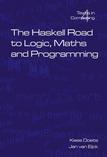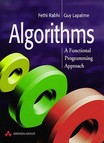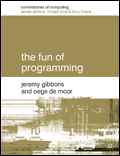My favourite scheme implementation is scheme48, which takes its name from its being initially implemented in 48 hours by Richard Kelsey and Jonathan Rees in August 1986. They used Common Lisp on a Symbolics 3600 and Maclisp on a PDP-10.
Now, thanks to Jonathan Tang’s tutorial, you can write yourself a scheme in 48 hours, but using Haskell instead of Lisp. The tutorial is intended as an introduction to Haskell for Schemers (and (brave) programmers in general) wanting to get started in the purest member of the functional family. And it is extremely fun, for instead of following the boring language features overview way, it plunges right on in interesting, hands-on stuff like parser combinators (one of the most beautiful applications of Haskell, if you ask me) or monads. The lessons include exercises, so that you have really no excuse for not learning Haskell once and for all. Believe me, it’s good for your (mental) health.
If you’re totally new to Haskell and find the pace of Jonathan’s tutorial a bit hard to follow, you may start with a tour of the Haskell syntax and the Hitchikers’ guide to Haskell, after making sure, of course, that you have your towel at hand. As for me, well i’ve been planning to learn Haskell for some years now and, since i happen to love books, i have accumulated a little (but selected) Haskell library, together with a sort of learning roadmap that, unfortunately, i have yet to complete. Just in case the above links whetted your appetite and you happen to have more time than i do, here you have my bookworm guide to Haskell enlightenment.
The little Haskeller
There are many introductory Haskell books, but i was (at the time i started learning) keen of those providing also a good basis on functional programming (which was a totally new world for me at the time). Therefore, my first Haskell book, and still a wholehearted recommendation, was Richard Bird and Philip Wadler‘s Introduction to Functional Programming Using Haskell, one of the most elegant books on programming i’ve ever read.
 One of the nicest things about writing Haskell code is that it’s the closest one can probably get to writing pure maths while programming. Thus, learning Haskell is an excellent way to learn more about maths and logic. If that sounds to you like doubling the fun (and you’re not yet a math wizard), The Haskell Road to Logic, Maths and Programming (see also this extensive review (PDF)) by Jan van Eijck and Kees Doets is definitely the book for you. Its purpose is to teach logic and mathematical reasoning in practice, and to connect logical reasoning with Haskell programming. And, in my opinion, it does a pretty good job at that. Although it begins with the very basics, it includes chapters on far from trivial (i.e., fun!) stuff like, for instace, corecursion or Cantor sets. And i found amazing how natural it was to express logical and mathematical ideas in Haskell.
One of the nicest things about writing Haskell code is that it’s the closest one can probably get to writing pure maths while programming. Thus, learning Haskell is an excellent way to learn more about maths and logic. If that sounds to you like doubling the fun (and you’re not yet a math wizard), The Haskell Road to Logic, Maths and Programming (see also this extensive review (PDF)) by Jan van Eijck and Kees Doets is definitely the book for you. Its purpose is to teach logic and mathematical reasoning in practice, and to connect logical reasoning with Haskell programming. And, in my opinion, it does a pretty good job at that. Although it begins with the very basics, it includes chapters on far from trivial (i.e., fun!) stuff like, for instace, corecursion or Cantor sets. And i found amazing how natural it was to express logical and mathematical ideas in Haskell.
 But maybe you prefer to learn a bit of applied Computer Science, instead of abstract maths, with Haskell. No problem: just grab a copy of Fethi Rabhi and Guy Lapalme‘s Algorithms, a functional programming approach, which challenges the academic establishment by teaching algorithms using Haskell, that is, in a purely functional context. Revisiting classical (and apparently imperative) algorithms like sorting, tree and graph traversal or dynamic programming methods under a functional light is a refresing experience, and an eye-opener: the fact that all the typical algorithms are covered in just 256 pages is a testament to the authors’ claim that functional programming leads to smaller, clearer and more elegant program. Besides, as you probably know, Haskell features lazy evaluation, which poses entirely new (and pretty instructive) challenges when it comes to evaluating the efficiency of an algorithm.
But maybe you prefer to learn a bit of applied Computer Science, instead of abstract maths, with Haskell. No problem: just grab a copy of Fethi Rabhi and Guy Lapalme‘s Algorithms, a functional programming approach, which challenges the academic establishment by teaching algorithms using Haskell, that is, in a purely functional context. Revisiting classical (and apparently imperative) algorithms like sorting, tree and graph traversal or dynamic programming methods under a functional light is a refresing experience, and an eye-opener: the fact that all the typical algorithms are covered in just 256 pages is a testament to the authors’ claim that functional programming leads to smaller, clearer and more elegant program. Besides, as you probably know, Haskell features lazy evaluation, which poses entirely new (and pretty instructive) challenges when it comes to evaluating the efficiency of an algorithm.
The seasoned haskeller
 Once you’re comfortable with the language and have learnt all about monads, the best thing to do is to study non-trivial Haskell applications. To that end, you can hardly find a better book than The fun of programming, a Festschrift celebrating Richard Bird’s sixtieth birthday. Including thirteen chapters by luminaries in the field, this book describes fun applications on such fun things as musical composition or graphical design, as well as covering advanced programming techniques such as data structures design, interpreters or optimization. Amazing.
Once you’re comfortable with the language and have learnt all about monads, the best thing to do is to study non-trivial Haskell applications. To that end, you can hardly find a better book than The fun of programming, a Festschrift celebrating Richard Bird’s sixtieth birthday. Including thirteen chapters by luminaries in the field, this book describes fun applications on such fun things as musical composition or graphical design, as well as covering advanced programming techniques such as data structures design, interpreters or optimization. Amazing.
I also own a copy of Paul Hudak‘s The Haskell School of Expression, which is often recommended as as Haskell primer. In my opinion, it goes too quickly into the nitty-gritty details of (music and multimedia) implementations to be a good first book, but it is probably a good second book on Haskell programming. But that’s just me: as you can read in the review above, some people have diverging opinions.
The fun never ends…
After all these readings, and a bit more about monads, you’ll begin to feel an expert, and may be interested in more advanced stuff. I’ve got a couple of books reserved for that moment. The first one is The Algebra of Programming, by Richard Bird and Oege de Moor, and its purpose, simply stated, is to show how to calculate programs algebraically using and old friend of ours: category theory, including the bananas that will be the main theme of my second post on these matters. There you’ll find and in-depth, abstract treatment of algorithmic strategies with an eye of correctness proofs. Although heavy on theory, there are interesting applications of this algebra of programming, like the conversion between binary and decimal numbers in TeX, the best way of drawing a cylinder in LaTeX or good data compression algorithms. A slight nuisance is that this book uses an old Haskell dialect (a precursor, actually) called Gopher, but the conversion to modern notation is pretty straightforward. Finally, anyone serious about algorithms and data structures should read Chris Okasaki’s Purely Functional Data Structures, and amazing tour on advanced algorithimcs using functional programming languages, with source code in SML and Haskell. The exposition is extremely elegant and synthetic, and i’ve spent many, many hours immersed in its 220 pages (i can’t think of any other programming book with a better signal to noise ratio, really).
Finally, anyone serious about algorithms and data structures should read Chris Okasaki’s Purely Functional Data Structures, and amazing tour on advanced algorithimcs using functional programming languages, with source code in SML and Haskell. The exposition is extremely elegant and synthetic, and i’ve spent many, many hours immersed in its 220 pages (i can’t think of any other programming book with a better signal to noise ratio, really).
That’s it. I just hope that 48-hours days are invented any time soon. Happy reading!






March 28, 2006 at 6:29 am
[...] 그 외에 http://jaortega.wordpress.com/2006/03/28/a-haskell-bookshelf/에 소개된 책들을 읽어보는 것도 괜찮겠다. [...]
March 29, 2006 at 10:02 am
Wow, an impressive set of links. It looks like you’ve laid out all the resources anybody would need to dive into the Function/Haskell world.
March 29, 2006 at 12:43 pm
I’ll be sure to check out the “Write yourself a Scheme in 48 hours” tutorial. I’ve been playing with Scheme ( and Common Lisp ) lately, and it’s great fun. If I’ve understood it right, Haskell is a more “pure” functional language than the various Lisps?
March 29, 2006 at 5:51 pm
[...] This guy is interesting and has several good articles on programming, though I think this is my favorite so far. [...]
March 30, 2006 at 2:26 pm
Yes. Wow, an impressive set of links. Really.
April 1, 2006 at 3:23 pm
Simen, that’s right: Haskell is usually considered more purely functional because it does not allow side-effects (no mutable variables). When they’re absolutely necessary (e.g., in input/output operations), they’re hidden away inside monads. Another interesting feature separating Haskell from Lisp (although this one does not make it ‘more functional’) is lazy evaluation. In general, as any lisper will tell you, Lisp (and specially Common Lisp) tries hard not to impose a single paradigm (functional or any other) on you (at the cost, sometimes, of convenience: e.g. lazy evaluation is possible but a bit cumbersome).
April 13, 2006 at 1:53 am
Very nice list. I learnt Haskell from Simon Thompson’s Craft of functional programming. One other excellent resource for advanced Haskell programming, indeed the one I consider to have been most helpful in my experiance, is the wiki on haskell.org.